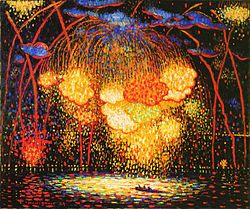- Edward Middleton Manigault
-
Edward Middleton Manigault (June 14, 1887 – August 31, 1922) was an American Modernist painter.
Manigault was born in London, Ontario on June 14, 1887.[1] His parents were Americans originally from South Carolina.[1] Encouraged in art from an early age, he was commissioned at the age of 18 the city of London to make renderings of public buildings for reproduction as postcards.[2]
Manigault moved to New York City in 1905 and enrolled in classes at the New York School of Art.[1] He studied under Robert Henri and Kenneth Hayes Miller. He moved away from Realism by 1909 and began producing paintings in a Post-Impressionism style. He first exhibited his work in New York that year, and in 1910 participated in the Exhibition of Independent Artists, which Henri had organized.[1] In the spring of 1912, he traveled through England and France. In 1914, he staged a critically acclaimed one-man show at the Charles Daniel Gallery.[1] His art was purchased by such notable collectors as J. Paul Getty and Arthur Jerome Eddy.[2]
Manigault volunteered to serve as an ambulance driver with the British Expeditionary Force in 1915, during World War I.[1] He married Gertrude Buffington Phillips two days before he shipped out. Manigault served as an an ambulance driver in Flanders from April to November of 1915.[1] He received a medical discharge after being exposed to mustard gas; he suffered a nervous breakdown and his health would decline for the remainder of his life.[2]
Manigault worked in a wide range of styles following the war, experimenting in abstract and Cubist styles that he found unsatisfying and mostly destroyed.[1] He was inspired by the example of American modernists, including William and Marguerite Zorach. In 1919 he and his wife resettled in the Echo Park district of Los Angeles, California.[2] Manigault subsequently became inspired by the Arts and Crafts Movement, and began to produce decorative works, including ceramics and furniture.[2] He also was commissioned by Oneida Limited to design flatware.[2]
Exacerbating his poor health, Manigault practiced fasting in an attempt "to approach the spiritual plane and see colors not perceptible to the physical eye."[1] His wife normally monitored his habits, and after he traveled alone to San Francisco to work on a job, he collapsed and was hospitalized.[2] He died on August 31, 1922 of starvation and neurasthenia.[2]
Manigault is believed to have destroyed as many as two hundred of his paintings; consequently, few paintings by Manigault survive.[1] His work notebooks only cover the years from 1906 to 1919.[1] Interest was renewed in his work in 1946, with the inclusion of his paintings in the exhibition "Pioneers of Modern Art in America 1903-1918" at the Whitney Museum of American Art.[1] His work is in the permanent collections of the Columbus Museum of Art in Columbus, Ohio, and the Gibbes Museum of Art in Charleston, South Carolina.
References
- ^ a b c d e f g h i j k l Roberts, Norma J., ed. (1988), The American Collections, Columbus Museum of Art, p. 68, ISBN 0-8109-1811-0.
- ^ a b c d e f g h Ptach, Dave (Summer 2005), Historic Echo Park "Fellowship Parkway Artist Fasted for Sake of Vision", Echo Park Historical Society News, http://www.historicechopark.org/id124.html Historic Echo Park, retrieved August 29, 2011.
Further reading
- Beth Venn, Nannette Maciejunes, and Angela Mack (2001). Middleton Manigault: Visionary Modernist. New York: Hollis Taggart Galleries. ISBN 0-9705723-5-2.
External links
Categories:- 1887 births
- 1922 deaths
- Modern painters
- Artists from New York City
- People from London, Ontario
- People from Echo Park, Los Angeles
Wikimedia Foundation. 2010.


